On October 16th, 1907, the Japanese Battleship Katori (香取 (戦艦)) entered the Korean port of Inchon. On board was Japan’s Crown Prince Yoshihito (嘉仁), who was to become the future Emperor Taisho(大正天皇). He had come for a 5-day visit to Korea, staying until Oct. 20th.
Preparations for the departure of the Crown Prince included taking 148 Japanese Orders to present to the Koreans during his stay there. A Collar set of the Supreme Order of the Chrysanthemum was given to retired Korean Emperor Kwangmu, three sets of the Grand Cordon of the Order of the Rising Sun with Paulownia Flowers were given to Korean Royals. In addition, another 69 sets in various classes of the Order of the Rising Sun and 75 sets in various classes of the Order of the Sacred Treasure were also awarded during the visit.
Japan’s Crown Prince’s Trip/Visit to Korea Commemorative Medal 皇太子渡韓記念章1
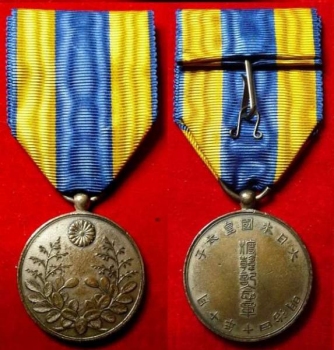
On March 27, 1909, almost 1½ years after the visit, a medal was established to commemorate the trip to Korea.
A proposal for creating the medal was originally submitted by the Decorations Bureau on June 16, 1908, and it was approved by the Legislation Bureau on July 6th. The original draft version of the awarding rules, did not specifically call out giving the medal to Koreans, and merely said it was “to be awarded to those involved in the Crown Prince’s Korea visit of October 1907”. A revised proposal appeared on January 19, 1909, which now stated that the medal was “to be awarded to Korean and Japanese Royal family members as well as government officials of both nations, who were involved in the Crown Prince’s Korea visit of October 1907”. The medal was endorsed by the Emperor Meiji (明治天皇) on March 27, 1909 by Imperial Edict #42. The Peterson Monograph on Orders and Medals of the Japan and Associated States2 has the date as the March 29th, which is actually the day it was entered into the Official Gazette (官報. 1909年03月29日)3
The Obverse side of the medal features crossed sprigs of sandalwood representing Korea with a chrysanthemum crest above it, representing Japan. At the top of the reverse, it says 大日本国皇太子 “Crown Prince of the Great Empire of Japan” (대일본국황태자). The text running vertically down the center is 渡韓記念章 “Commemorative Medal for Korea Visit” (도한기념장). At the bottom is the date 明治四十年十月 “40th Year of Meiji, October” (명치사십년십월). The 1967 Peterson monograph 4 calls the medal, the “Crown Prince’s Voyage to Korea Commemorative Medal”, there is actually no reference to a voyage in the Japanese text. It was corrected in later versions of the Peterson monograph, which now refers to the medal as ”Imperial Tour Commemorative Medal”. A more accurate translation is “Crown Prince’s Trip/Visit to Korea Commemorative Medal”. This was the last Japanese medal, which had a version in gold for royal family members. The ribbon is 37 mm watered silk, with a dark blue 16 mm center stripe, flanked on each side by 9.5 mm yellow stripes and 1 mm dark blue edge stripes. The edict stipulated that it was to be worn on the left side of the chest, but says nothing about a women’s version. The case is a typical black lacquered case with a red inlay. Unfortunately, there is no information on issue or production numbers. By whatever means you use, this is an exceedingly rare medal. Guesstimates of numbers issued are in the 250+ range.
Korea’s Reciprocal Medal
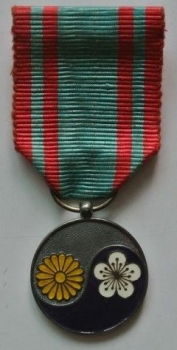
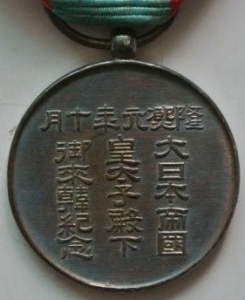
I have no good/factual information on the Korean Medal for the Japanese Crown Prince’s Trip to Korea. There are a few Korean websites which show or at least refer to the medal, but none of them have any factual information and give reference sources. There was a palace fire recorded on Nov. 10, 1917 in which valuable items, described as “Honors (勳記), Medals (勳章), Insignia (徽章), and Commemorative Plaques (記念章)” were destroyed. This could possibly explain the lack of records if they had been stored with the medals, but I have no information of substance. There is no information about this medal in the Annals of Emperor Sunjong. 5 It is suspected that the fire mentioned above, is also responsible for the loss of Emperor Kojong’s and Emperor Sunjong’s foreign decorations.
The Japanese medal is exceedingly rare, but the Korean Medal is far rarer. One unsubstantiated source states that there were 27 made in silver and 10 in platinum 백금.6 The only thing I can offer is a picture of the medal and a translation of the text on the reverse side. The top line is 隆熙元年十月 Yunghui 1st year 10 month (October 1907) 융희원년십월 and the three columns are 大日本帝國皇太子殿下御來韓紀念 Commemorating the visit of the Imperial Prince of Japan to Korea 대일본제국황태자전하어내한기념.
You will find this information duplicated on my “Commemorative Medals” Page under the Korean Empire listing. Link to the blog post and picture source. Another blog post, picture source, same owner.7
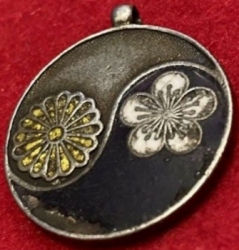
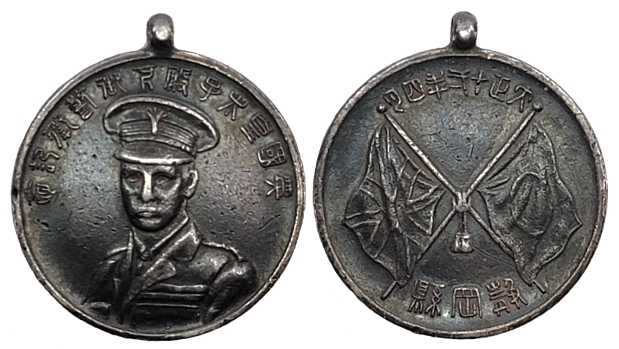
Obverse: 英國皇太子殿下御警衛記念 Commemoration of His Royal Highness the Crown Prince.
Reverse: 大正十一年四月, Taisho 11th Year, 4th Month (April 1922) and 靜岡縣 Shizuoka Prefecture.
Some extraneous information:
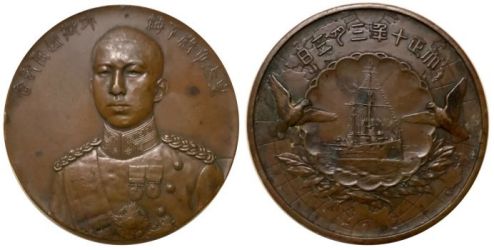
Notice the Battleship Katori on the reverse.
The two birds probably signify the Crown Prince and his wife.
The Korea that Crown Prince Yoshihito visited in 1907 did not qualify as a foreign country. At the time, Korea was a Japanese Protectorate and was annexed only 3 years later. The trip should be considered a domestic hop within Japan.
The first member of the Japanese Royal Family to officially travel abroad was Crown Prince Hirohito.8 His trip began on March 3, 1921, and included stopovers in the United Kingdom, France, Italy, the Netherlands, and Belgium. His original itinerary included a visit to the United States, but the violent suppression of the March 1st, 1919 demonstrations in Korea, caused a great deal of anti-Japanese sentiment in the United States. Those planning the trip were hesitant to expose the Crown Prince to possible danger. Upon his return to Japan at the age of 20 he became Regent of Japan on November 25, 1921. His ailing father was suffering from mental illness and died five years later on December 25, 1926.
Interestingly enough, Crown Prince Hirohito was transported to Europe on board the same battleship, the Katori, which had carried his father, the Crown Prince Yoshihito to Korea. The Katori was one of two battleships designed and built for the Empire of Japan by the British shipyard Vickers. The Katori was scrapped at the Maizuru Naval Arsenal in 1925 in accordance with the terms of the Washington Naval Treaty of 1922.
The Hirohito commemoration medal is a 61 mm bronze medal, designed by S. Nakano. It has the Osaka Mint hallmark on edge. Also found in silver with a suspension loop, but I have no idea of the ribbon colors.
Of course, any official visit by Royalty from one country to another, must have a reciprocal visit. The following year, after Japan’s Crown Prince visited England, Crown Prince Edward of England visited Japan.
Footnotes:
- Information Source: War Relics Forum
- Orders and Medals Society, Monograph #1, originally published 1967
- Official Gazette Entry
- op. cit.
- Both the Annals of Emperor Kwangmu and those of Emperor Sunjong are suspect because they were compiled by the Japanese, who had their own agenda when it came to accurately recording Korean history.
- In modern Korean 백금 is used for platinum, while the term 화이트골드 is used for white gold. I don’t know if that was also the common usage in the early 1900s.
- The pictures used here are from a 2016 Korean blog post. Unfortunately, because I do not have a Korean Citizen Identification Card, I cannot communicate with the author. If you can communicate with the author, please have him get in touch with me.
- b. Apr. 29, 1901—d. Jan. 7, 1989
